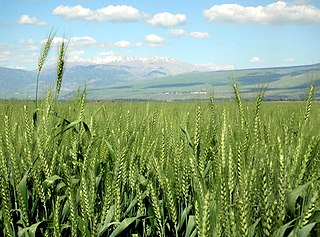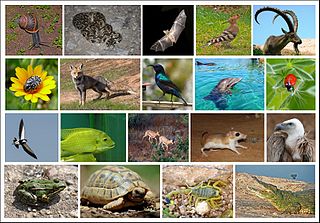
Cypriniformes is an order of ray-finned fish, including the carps, minnows, loaches and relatives. This order contains 11-12 families, over 400 genera, and more than 4,250 species, with new species being described every few months or so, and new genera being recognized frequently. They are most diverse in southeastern Asia, and are entirely absent from Australia and South America.

The Hula Valley is an agricultural region in northern Israel with abundant fresh water. It is a major stopover for birds migrating along the Syrian-African Rift Valley between Africa, Europe, and Asia. The marshland around Lake Hula, a breeding ground for mosquitoes carrying malaria, was drained in the 1950s. A small section of the valley was later reflooded in an attempt to revive a nearly extinct ecosystem. An estimated 500 million migrating birds now pass through the Hula Valley every year.

Fish are gill-bearing aquatic craniate animals that lack limbs with digits. They form a sister group to the tunicates, together forming the olfactores. Included in this definition are the living hagfish, lampreys, and cartilaginous and bony fish as well as various extinct related groups. Tetrapods emerged within lobe-finned fishes, so cladistically they are fish as well. However, traditionally fish are rendered paraphyletic by excluding the tetrapods. Because in this manner the term "fish" is defined negatively as a paraphyletic group, it is not considered a formal taxonomic grouping in systematic biology, unless it is used in the cladistic sense, including tetrapods. The traditional term pisces is considered a typological, but not a phylogenetic classification.

The wildlife of Israel includes the flora and fauna of Israel, which is extremely diverse due to the country's location between the temperate and the tropical zones, bordering the Mediterranean Sea in the west and the desert in the east. Species such as the Syrian brown bear and the Arabian ostrich have become extinct in Israel because of their loss of habitat. As of May 2007, 190 nature reserves have been established in Israel.
Acanthobrama centisquama, also known as the long-spine bream or Orontes bream, is a species of freshwater fish in the Cyprinidae family. It is known from Syria and Turkey, and there restricted to Lake Amik and al-Gab Lake. Lake Amik has been drained, and this species has not been found here since the early 20th century, and may be extinct. There may be remnant populations present in Gölbaşı Lake, which is impacted by pollution and water abstraction.

Acanthobrama is a genus of ray-finned fish in the Cyprinidae family found mostly in the Near East.
Acanthobrama lissneri, or the Jordan bream, is a species of freshwater fish in the Cyprinidae family. It is found in Israel and Jordan. Its natural habitats are rivers and lakes, and is now commonly found in reservoirs.
Acanthobrama terraesanctae, the Kinneret bream or Kinneret bleak, is a species of freshwater fish in the Cyprinidae family. It is known from two lakes: Lake Tiberias, Israel, and Lake Muzarib, Syria. This is a small planktivorous fish, typically about 14 cm long, occurring near surface in large schools. It is very abundant in Lake Tiberias, whereas there is little information on the other lake, which is small (0.5 km2) and can hold a small population anyway.
Acanthobrama hulensis, sometimes known as the Hula bream, was a species of ray-finned fish in the family Cyprinidae. Its natural habitats were swamps and freshwater lakes in Lake Hula in northern Israel. Acanthobrama hulensis looked much like a sardine. In Israel other members of the genus often are called "sardin" in culinary terms.

Acanthobrama telavivensis, commonly known as the Yarkon bream or Yarkon bleak, is a species of freshwater ray-finned fish of the family Cyprinidae found only in Israel, in the Yarkon River system.
Tristramella intermedia is an extinct species of fish in the Cichlidae family. It was endemic to Lake Hula in northern Israel. This taxon was considered to be a subspecies of T. simonis in FishBase and considered a synonym of T. simonis by Catalogue of Fishes, a view with which FishBase now concurs. This species reached a length of 22.9 centimetres (9.0 in) TL.

The Leuciscinae, commonly known as true minnows, are a large subfamily of the freshwater fish family Cyprinidae.
Acanthobrama marmid, or the Mesopotamian bream or Tigris bream, is a species of freshwater fish in the Cyprinidae family. It is widespread and abundant in the Tigris–Euphrates river system. It lives in many kinds of lowland waters, and can also tolerate modified water bodies such as reservoirs and moderately-polluted rivers.
Acanthobrama microlepis, called the blackbrow bleak or the Caucasian bream, is a species of freshwater fish in the Cyprinidae family. It reaches a maximum size of 25 cm (9.8 in) TL. The species is found in lakes and rivers of the southwestern Caspian Sea drainage basin, including Sefīd-Rūd, Kura River and Aras River. It has also been introduced to Iraq.
Acanthobrama tricolor, or the Damascus bream, is a species of freshwater fish in the Cyprinidae family. It is endemic to Syria and the Golan Heights, and is recently only known two specimens found in the Masil al Fawwar river system in the late 1980s. It has been extirpated from the Barada river system, where it has not been seen since 1908. It is considered Critically Endangered, and may possibly be extinct, but no studies of the river systems in the Golan Heights have been conducted, and it may still survive there, but the lower Barada is now dry, and the middle portions of the river are heavily polluted.
Acanthobrama hadiyahensis , also known as the Arabian bream, is a species of freshwater cyprinid fish, which has been described from Wadi Hadiyah, Saudi Arabia.
Acanthobrama orontis is a species of freshwater cyprinid fish, which is endemic to Turkey.
Acanthobrama persidis is a species of freshwater cyprinid fish, which is endemic to Iran.
Acanthobrama urmianus is a species of freshwater cyprinid fish, which is endemic to Iran.






